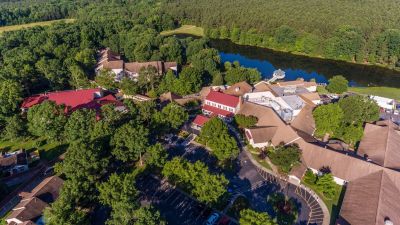You’ve considered your senior living options, such as remaining in your current home or downsizing, and determined that a retirement community move is the best choice for you. But how do you decide which retirement community is the best fit for your goals? Obviously, cost must be taken into consideration, but what are your other retirement community decision priorities?
To make the decision feel less overwhelming, some people take a top-down approach to their retirement community analysis process. They start at the macro level — the big aspects of the decision — and then work their way down to the micro level. Here’s what that might look like.
Community location
 Choosing where you want to live geographically is probably the biggest of the decisions when selecting a retirement community. Some people are drawn to the warmer climate of a place like Arizona. Maybe you want to be near the water, in which case Florida or North Carolina might be a good option for you.
Choosing where you want to live geographically is probably the biggest of the decisions when selecting a retirement community. Some people are drawn to the warmer climate of a place like Arizona. Maybe you want to be near the water, in which case Florida or North Carolina might be a good option for you.
Some older adults opt to move to a retirement community in a location that is closer to adult children and/or grandchildren. This decision can have drawbacks though. If those family members have to move away for whatever reason, you can be left in an area that may otherwise not have much appeal to you.
For some people, the best retirement community option is a community in their current town. (In fact, CCRCs draw the majority of their residents from about a 10-mile radius.) This choice enables you to remain close to nearby friends and family. You’ll already be familiar with how to get places, you’ll know what the best restaurants are, and it is nice to be able to keep your existing healthcare providers.
Community type
Retirement communities come in many forms. You should consider if you want to own or rent your home, and if access to care services is a priority to you.
Some are essentially planned neighborhoods for people who are 55 and older (or sometimes 62 and older, depending on the community’s charter). In this type of retirement community, you buy a home as you would any other residence. You’ll typically pay monthly HOA dues, which will cover exterior maintenance and certain community amenities (like a pool and clubhouse), similar to many other non-age restricted communities.
Other retirement communities are more like an apartment where residents pay monthly rent or an annual lease — they do not own their residence. These communities may have single-family houses or cottages and/or multi-unit buildings. Here again, your rent would typically include exterior maintenance and possibly some interior maintenance, as well as any community amenities.
A continuing care retirement community (CCRC) or “life plan community” is a distinct type of retirement community that offers residents access to a continuum of care services, should the resident ever need them. Some CCRCs offer ownership of residences, and others have rental options.
Virtually all CCRCs have a monthly fee, and most will have an entry fee. The entry fee, which may be partially refundable, helps keep the monthly fee lower than what it would otherwise be, and in some cases, also reduces the cost of long-term care and healthcare services within the community, if needed.
Lifestyle and culture
 The lifestyle and culture of a retirement community pertains to the overall factors that impact your day-to-day living experience within the community. Your retirement community choice should enable you to live the life you want to live; you should feel comfortable and happy living there. It needs to be a good fit, so it is wise to spend as much time on the campus as possible to get a feel for life there. Talk to current residents, attend campus events, and if possible, spend the night as a guest.
The lifestyle and culture of a retirement community pertains to the overall factors that impact your day-to-day living experience within the community. Your retirement community choice should enable you to live the life you want to live; you should feel comfortable and happy living there. It needs to be a good fit, so it is wise to spend as much time on the campus as possible to get a feel for life there. Talk to current residents, attend campus events, and if possible, spend the night as a guest.
That being said, lifestyle and culture preferences are highly individualized. One person’s priorities may be quite different from another person’s. So, depending on the prospective resident, such considerations may include things like overall activity level of the community and its residents, lifelong learning opportunities, dining choices and meal plan flexibility, and/or community involvement and volunteer opportunities.
As a subset of lifestyle and culture, it’s also worth noting that the management and financial stability of the community should be taken into consideration, too. A retirement community is only as good as its administrators, so you’ll want to be sure you choose a community that is well-managed and, particularly for CCRCs, one that’s in good financial standing. Communities that thrive are usually those where residents are actively engaged with management and have a voice in the community, often through an active residents council.
Amenities
Amenities can vary quite drastically from one retirement community to the next. While most will have a swimming pool and a fitness center for residents, some communities will have more extensive amenities than others (and probably a correlated price point). For instance, there are communities that have golf courses, personal gardening plots, spas, nature trails, extra storage space, dog parks, and more. Some will offer housekeeping and even linen services.
Many retirement communities also offer residents opportunities to socialize with one another, either in organized or less formal gatherings. This might look like group games, happy hours, educational opportunities, performances, group outings, and more.
There may also be one or more on-site dining options. For communities with restaurants, a variety of meal plans will typically be offered to residents.
Residence type and floorplan
Once you have homed in on which community best meets your other retirement community priorities, it’s time to get down to the nitty gritty. Do you want to live in a house, a patio home, a condominium, or an apartment (and on what floor)? How many bedrooms and bathrooms do you want, and how much square footage? Do you want a private patio or balcony, or maybe a garage?
This is once again a personal preference, and each choice may have some pros and cons. For example, a larger residence, like a house or patio home, will typically cost more and may take more effort to keep tidy. A smaller residence can mean big cost-savings, but may feel cramped if you frequently entertain or have houseguests.
Focusing on your unique retirement community decision priorities
Making the choice to move to a retirement community is a major decision, which will impact your day-to-day life and happiness for years to come. There are a lot of factors that should be considered in order to find a community that is the best fit for your retirement community decision priorities. So, take the time to do your research and consider your various options.
Once you’ve narrowed down your list, it can be helpful to spend as much time as possible on the campuses of your top contenders. Talk to current residents, or even spend the night if the community has a guest suite. This will give you a more comprehensive feel for what it would be like to live there yourself.
To find out if RWC is the right financial fit for you, take this 7 question survey now!
By myLifeSite
